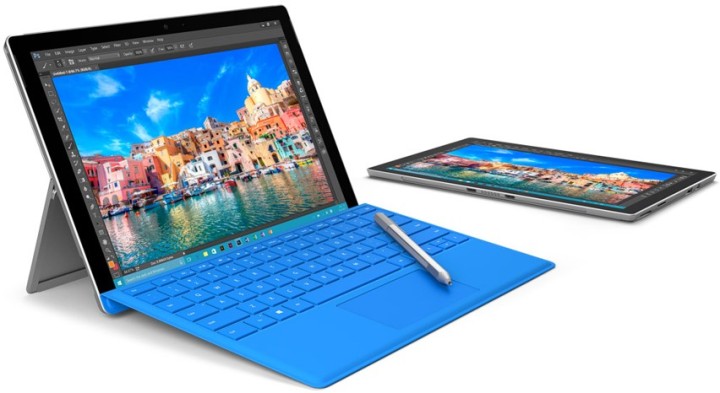Every few years Microsoft develops their own Surface-branded device to provide a user experience exactly as Microsoft intended. On October 26, 2015, Microsoft released the fourth retail revision of their Surface Pro line of convertibles: the Surface Pro 4. The star feature of this device was a brand new 12.3″ high resolution screen with a 3:2 aspect ratio.
Today we measure the North American 256GB storage variant of the Surface Pro 4 with software and firmware updates current to November 10, 2016.
FLICKER
When we measured the Surface Pro 3 we found it used an aggravatingly low flicker frequency of 200 Hz when brightness was set to 48% and below. Thankfully, this harsh PWM flicker could be entirely avoided at brightness settings of 49% and above but this made the screen too bright for most to tolerate.
Upon measuring the Surface Pro 4 we discovered high frequency flicker at brightness levels of 99% and below. In this case, flicker can only be avoided by setting screen brightness to maximum. Due to the bright nature of the screen at maximum brightness this setting may not be feasible for those most sensitive.
The measurements also indicate a high flicker percentage. Flicker percentage is the difference between highest and lowest light output every flicker cycle. With respect to the Surface Pro 4, it appears that when the display is set below ~80% brightness the screen is actually fluctuating on and off every cycle. At brightness of 80% and higher the light output appears to fluctuate between a bright and less bright state, but not totally off.
Fortunately, the Surface Pro 4 has one saving grace: flicker frequency. What makes the Surface Pro 4 flicker unique is the exceptionally high frequency – a remarkable 11.6 kHz. In other words, the Surface Pro 4 screen turns on and off 11,600 times every second. As higher frequency flicker is far more desirable than low frequency flicker, Microsoft has gone to an extreme length to satisfy many of the complaints with the Surface Pro 3.
While we aren’t aware of any research indicating that flicker in the range of 11.6 kHz has any effect whatsoever on even the most sensitive users, out an abundance of caution we would still have preferred no flicker at all, or that flicker be used only at lower brightness levels where it may be justified to achieve a darker screen while maintaining color accuracy.
There are some old reports online of the Surface Pro 4 flickering at a terribly low frequency of 50 Hz. This was said to occur when unplugged and/or below 50% brightness. In our testing on of the device running the latest firmware as of November 10, 2016 (106.1281.768), we were not able to reproduce this with any combination of settings. I expect this was originally the result of a software bug that has since been fixed.
Below are measurements of the light output produced by the Surface Pro 4 screen at various brightness levels. The percentages used to describe the brightness level are approximate as Microsoft has decided to remove these numbers from Windows and instead replace them with the following descriptions: darkest, darker, suggested, brighter and brightest.

COLOR SPECTRUM OUTPUT
Coming soon.
BRIGHTNESS RANGE
Subjectively speaking the brightness range of the Surface Pro 4 is quite good. The minimum brightness is suitable dim even for use in dark environments. Those looking for a bright screen will appreciate the eye-searing maximum brightness setting.
POLARIZED LENS COMPATIBILITY
For those sensitive to light few accessories are more valuable than polarized sunglasses. Polarized lenses work by filtering out photons oscillating horizontally. While natural light from the sun oscillates in all orientations, light from screens on most devices will all share a single orientation by design. If that orientation happens to be horizontal to your polarized glasses then the lenses may unfortunately block most, or all, of the image. Read more about it in our Learning Center.
Measurements are performed using our reference Maui Jim ‘276 Manu 65’ sunglasses utilizing brown/bronze polarized lens.
In portrait: approximately ~100% of the screen brightness is visible
In landscape: approximately ~5% of the screen brightness is visible
Polarized glasses are not compatible with the Surface Pro 4 when used in landscape mode.
SCREEN RESOLUTION CONSIDERATIONS
The Surface Pro 4 is equipped with an exceptionally high-resolution screen. With such a high resolution screen comes potential problems with applications appearing too small to use comfortably. Windows features a scaling mechanism to help reduce the effect of small features. As of Windows 10, this scaling feature works fairly well. Taking this one step further, those most sensitive users may prefer even larger visual elements than normal. We recommend exploring scaling to suit your tolerances. Scaling settings may be accessed in Windows 10 through Settings -> System -> Display -> “Change the size of text, apps, and other items: ###%”. For older devices running Windows 8, go to Control Panel -> Appearance and Personalization -> Display -> “Change the size of all items”.
FINAL THOUGHTS

The display on the Surface Pro 4 produces flicker but does so at a high frequency of 11.6 kHz therefore offsetting the negative impact on viewers. While flicker can only be avoided at 100% brightness, it results in an exceptionally bright screen not feasible for those sensitive to light. Furthermore the device is limited to portrait when used in conjunction with polarized sunglasses.
While we have no objective evidence that flicker at such a high frequency will lead to any discomfort for even those most sensitive, you may wish to spend some time with the Surface Pro 4 at a local retailer to gauge your own comfort with the device.
